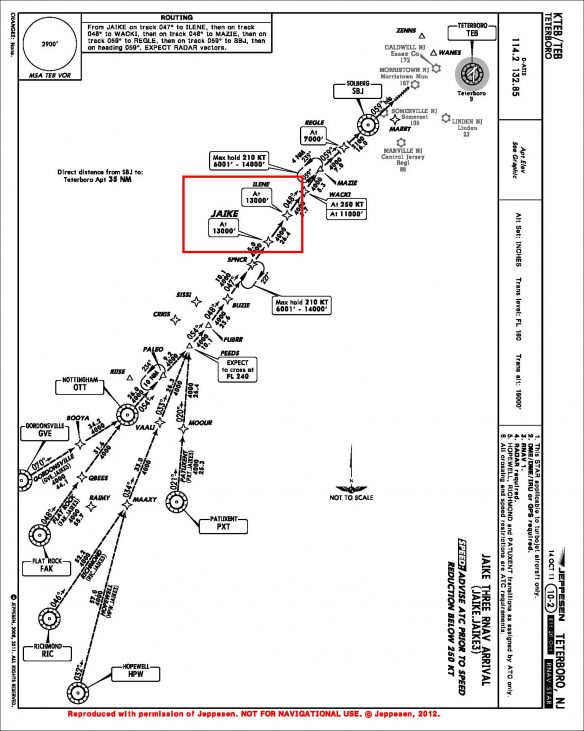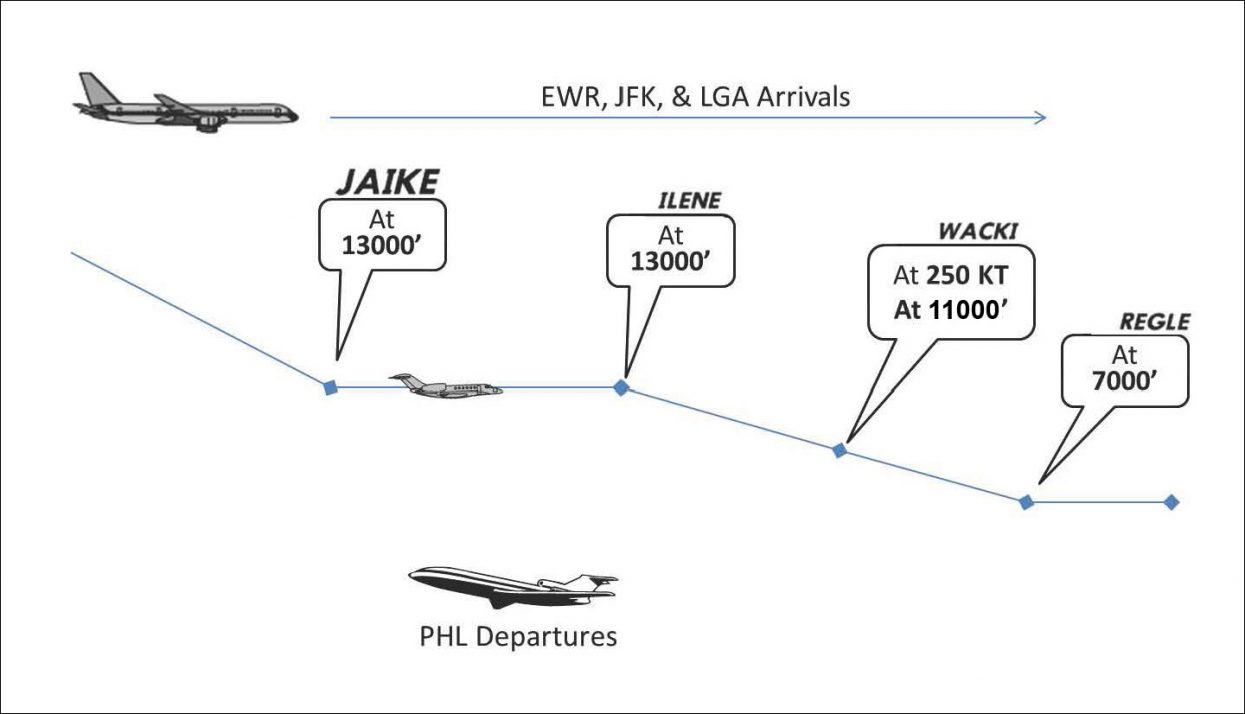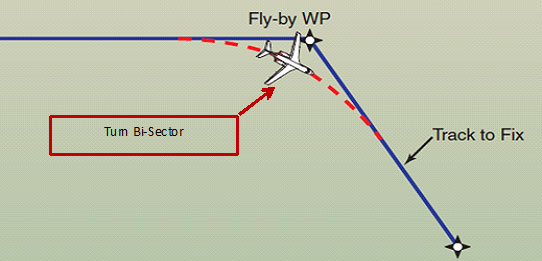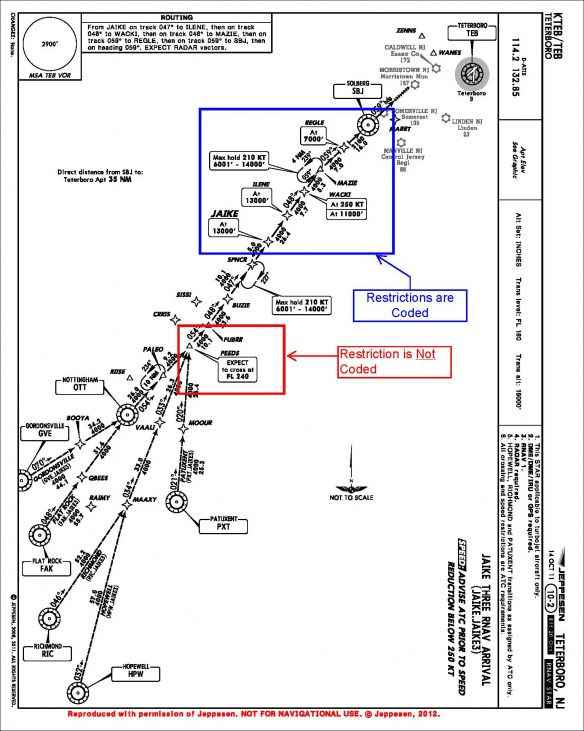July 6, 2012
The JAIKE RNAV STAR serves arrivals into Teterboro, NJ (TEB) and Morristown, NJ (MMU) airports. These RNAV STARs are specifically designed to take advantage of the lateral and vertical navigation capabilities of today’s modern RNAV-equipped aircraft.
The complexities of the Northeast US terminal airspace necessitate airplanes entering and exiting airspace boundaries at specific points and altitudes. The JAIKE Three’s vertical descent profile is design to separate inbound TEB & MMU arrival traffic with other New York arrival traffic passing overhead and with Philadelphia departure traffic passing beneath. The vertical separation requirements between these flows within this area are very tight.

Philadelphia TRACON is concerned over the growing number of deviations from the published altitudes on the JAIKE Three. Failure to comply with these published altitude restrictions will result in loss of separation between adjacent traffic thereby creating a significant safety hazard. During a recent controller shift, 4 out of 7 airplanes (57%) failed to comply with the “at” 13,000 restriction at ILENE (i.e. descended early after passing JAIKE at 13,000’. This is an unacceptably high pilot deviation rate for this procedure.
Automation Management

One reason often cited by pilots for these altitude deviations has been the unexpected or unanticipated operation of their aircraft’s VNAV system (e.g. VNAV initiated descent prematurely, etc.). As with all automation modes, pilots must be familiar with the VNAV operating modes for their aircraft, including the operation and transition between various sub-modes (e.g. VNAV Path, VNAV Speed, & VNAV Altitude). The transition between these sub-modes must be clearly understood and vigilance is required to ensure that these sub-modes transition as anticipated when using VNAV. Certain pilot actions may inadvertently disengage the VNAV flight guidance mode (e.g. actuating the Pitch/VS flight guidance controller wheel). It is also important to properly set the altitude preselector when using VNAV to vertically navigate the descent profile since in most cases the altitude preselector setting will override VNAV navigation.
The unexpected behavior of VNAV or their own unfamiliarly with their own aircraft’s VNAV system has resulted in some flightcrews electing to use other vertical modes for vertically navigating an RNAV STAR. Unfortunately, this can lead to its own set of problems. When queried as why they failed to comply with a restriction, pilots often respond that they failed to correctly identify the next published altitude restriction on the procedure. For example, pilots on the JAIKE Three have reported that they overlooked the published “at” 13,000’ restriction at ILENE. After complying with the “at” 13,000’ restriction at JAIKE these pilots began a descent to meet the next lower restriction (“at” 11,000’) published at WACKI, completely overlooking the “at” 13,000’ restriction published at ILENE. RNAV STARs are often associated with high workload with many inherent distractions (e.g. ATC frequency changes, receiving/updating the ATIS, coordinating with passengers, contacting the FBO, etc.). The use of non-VNAV automation modes increases the flightcrew’s workload in an already busy environment.
Another concern is the rate of descent during the last 1,000 feet prior to leveling at the VNAV altitude restriction. The vast majority of VNAV systems that are installed in business airplanes generally do not reduce the rate of descent during the last 1,000 feet before leveling at an altitude restriction. Whether it is because of tailwinds or that ATC issued a late descent clearance, VNAV may command descent rates exceeding 2,000 feet per minute during the last 1,000 feet before level-off. For passenger comfort reasons, some pilots use other automation modes (e.g. vertical speed). When using vertical modes other than VNAV, it is very important that pilots properly set the altitude preselector to the current altitude restriction and then advance the preselector for each subsequent altitude restriction, carefully cross-checking each published altitude on the procedure to ensure that they have indeed set the correct altitude.
A related concern regarding high descent rates during the last 1,000 feet of the descent prior to level off is the avoidance of nuisance TCAS TAs & RAs generated by nearby traffic. This concern has been well-publicized by the European authorities as a result of case histories of these events within their airspace. However, there are differences between SIDs & STARs in the United States and their Europe counterparts that US pilots must appreciate. The vertical profiles of both SIDs and STARs in the US are evaluated during their design against the surrounding airspace and traffic flows. Included in this evaluation is the interaction of the TCAS with anticipated vertical climb/descent profiles of each procedure and with other traffic flows in the surrounding airspace. The purpose of this evaluation is to design vertical profiles of these SIDs and STARs in a manner that avoids these disruptive, nuisance TCAS RA events. Therefore, when vertically navigating a US STAR or RNAV STAR, it is unnecessary to program along-track waypoints (i.e. a waypoint 5 miles early with the same altitude restriction) or to use other vertical modes to vertically navigate the STAR profile in order to permit a reduction in descent rate during the last 1,000’ of the descent to the published altitude restriction. It is perfectly acceptable to remain in VNAV mode throughout the final 1,000 feet of the descent through level-off. In fact, the procedure is designed so that an aircraft can use continuously remain in VNAV throughout the descent, with leg segments designed to allow for any necessary deceleration.
While not a problem on the JAIKE RNAV STAR, it is important to note that where lateral paths include a course change, the VNAV system will achieve the programmed altitude restriction at the turn bi-sector. When the course change is significant at the waypoint, the turn to the next leg may begin well before aircraft is at the programmed altitude. This should not cause undue alarm and should be anticipated when using VNAV.

Programming the FMS for a VNAV Descent
It is especially important that pilots correctly load the RNAV STAR, including the appropriate transition, and the runway transition (if applicable). For some more recent RNAV STARs, the routing and published altitude & speed restrictions are tied to a specific runway (e.g. Phoenix, AZ MAIER Five RNAV STAR).

Another important consideration is to verify the restrictions programmed for the procedure, when extracted from the FMS’s nav-databse, conform to the restrictions as published on the chart. Remember that “Expect” altitude and speed restrictions are not programmed in the nav-database for the procedure. Therefore, the pilot must enter these values as published on the chart when using VNAV to vertically navigate the STAR or RNAV STAR. In addition, some RNAV STARs may have a mandatory speed restriction, but also have an “Expect” altitude restriction at waypoint. Unless annotated “Expect”, the published altitude or speed restriction will be coded in the nav-database for the applicable waypoint on a STAR or RNAV STAR.
“Descend Via”
DESCEND VIA – Used in an ATC clearance to authorize a pilot to navigate vertically and laterally on a STAR/RNAV STAR. The pilot is responsible to meet all published speed and altitude restrictions. Descent can be made at the discretion of the pilot.
Descend via has been in use within the US National Airspace System for many years. Clearance to “descend via” authorizes pilots:
- To vertically and laterally navigate on a STAR/RNAV STAR.
- When cleared to a waypoint depicted on a STAR/RNAV STAR, to descend from a previously assigned altitude at pilot’s discretion to the altitude depicted for that waypoint.
- Once established on the depicted arrival, to navigate laterally and vertically to meet all published or assigned speed and altitude restrictions.
The “Descend via” clearance has been in use in the US NAS for a long time now, and most pilots are familiar with its use and phraseology. However, there are new changes to this clearance that will commence on 15 August 2012, concurrent with the introduction of “Climb Via”. Once such change is new phraseology for “descend via” will require the pilot to include the runway transition (if applicable) on initial contact with a new controller:
“Gulfstream 1234X leaving FL 210 descending via the JOHNN One arrival, runway two one transition.”
Remember that a “descend via” clearance authorizes the aircraft to navigate laterally and vertically to meet all published restrictions Descent/climb at the pilot’s discretion. Subsequent issuance of a “maintain” clearance deletes published altitude restrictions.
Flightcrew Considerations for Laterally & Vertically Navigating a STAR or RNAV STAR
Preparation for using a STAR or RNAV STAR begins well prior to the descent. The following actions are recommended prior to descent:
- Carefully review the STAR or RNAV STAR. Identify any “at”, “at or above”, “at or below”, or “window” altitudes (e.g. “at or above” and “at or below”) altitude restrictions that are published on the procedure.
- Brief the procedure with all flight crewmembers – including planned selections of Lateral and Vertical modes, use of autothrust
- If not using VNAV, carefully brief altitude preselector settings for each step-down on the procedure.
- Confirm the flight management system navigation and the automation programming & modes, are properly set and verified against the published STAR/RNAV STAR procedure information:
- En route transition
- Arrival runway, if known (inquire with ATC)
- Waypoint sequencing, including altitude and/or speed restrictions
- Review any specific aircraft or navigation operating procedures
- Do not modify or manually construct waypoints or modify altitude/speed constraints in the FMS unless amended by ATC instructions.
Summary
The complexities of busy terminal airspace require close adherence to the published lateral and vertical flight profiles. RNAV SIDs and RNAV STARs are increasingly being used to leverage the capabilities of the modern aircraft FMS & VNAV systems to make the best use of the available airspace in order to maximize the number of aircraft that can be accommodated within that airspace block. Pilots of advanced automated aircraft must ensure that they adhere to the prescribed vertical profile, regardless of which automation modes they elect to use. If they choose to use the most advanced VNAV modes, they must be thoroughly familiar with its operation.


 International Business Aviation Council Ltd.
International Business Aviation Council Ltd.